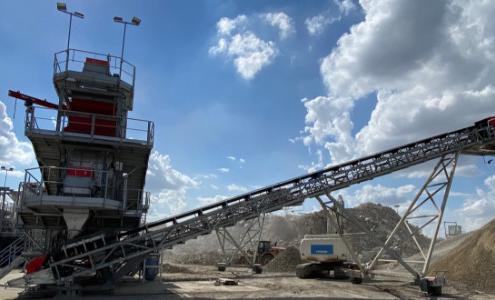Plant-based binders to fight dust
The problem of dust formation
Dust formation is a common problem in many environments, such as construction sites, mines and quarries. Dust can be generated by various activities, such as the movement of materials, grinding, crushing or the passage of vehicles. It consists of fine particles suspended in the air, which can have harmful consequences for human health, the environment and air quality.
Negative impact of dust on health and the environment
Dust poses numerous risks to human health, including respiratory problems, allergies, eye and respiratory tract irritation, and even serious respiratory illness. In addition, some dust particles may contain toxic substances, such as heavy metals or carcinogens, which can have long-term effects on health.
In environmental terms, dust can contribute to air and water pollution. It can also disrupt natural ecosystems by affecting vegetation, soil and local wildlife. In addition, the dispersion of dust can reduce visibility, leading to additional safety risks in certain contexts, such as driving machinery or handling operations.
The use of plant-based binders as a solution to reduce dust formation
In this article, we look at how plant-based binders can be used as an effective solution for reducing dust formation. Plant-based binders offer potential advantages over other dust control methods, such as their environmentally friendly nature, their compatibility with the environment and their ability to capture dust particles. We will explore the mechanisms of action of plant-based binders, their applications in different sectors and the practical considerations associated with their use. By promoting the use of plant-based binders, we are aiming to improve human health, reduce environmental impact and promote safer, more sustainable working environments.
Understanding plant-based binders
Definition and properties of plant-based binders
Plant-based binders are substances of plant origin that have the ability to bind to dust particles and form a protecting layer. These substances are generally extracted from plants or derived from plant products, such as gums, resins or cellulose extracts. Plant binders can be in powder, liquid or gel form, and can be natural or synthetic.
Plant-based binders have certain desirable properties for dust control. They have a high adhesion to dust particles, enabling them to capture them effectively. They are also often biodegradable, non-toxic and environmentally friendly, making them an environmentally friendly alternative to more traditional dust control methods.
Different types of plant-based binders to combat dust
There are many different plant-based binders used for dust control. Some common examples include natural gums, such as gum arabic and guar gum, plant resins, such as rosin and copal, and modified cellulose extracts. Each type of plant binder has specific properties that determine its effectiveness in dust control.
Advantages of plant-based binders over other dust control methods
Plant-based binders can offer a number of advantages over traditional dust control methods. First of all, they are usually of natural origin, which reduces their impact on the environment and makes them more acceptable from a sustainability point of view. Moreover, plant-based binders have a good capacity to adhere to dust particles, enabling them to be captured and retained effectively.
Plant binders can also be applied in a variety of ways, including spraying, spreading or incorporating them into materials. This versatility of application means that they can be used in a variety of contexts and adapted to the specific needs of each situation. Also, plant-based binders can be used at relatively low concentrations while maintaining their effectiveness, which can lead to a reduction in costs compared with other methods.
To summarize, plant-based binders offer significant advantages in the fight against dust, thanks to their natural origin, their efficiency in capturing particles and their versatility in application. Their use can help to reduce the negative impact of dust.
Action mechanisms of plant-based binders against dust
Capturing dust particles
Plant binders act by capturing dust particles present on the ground. This capture is facilitated by the plant binder’s ability to adhere to the dust particles. Plant binders have the property of interacting chemically with dust particles, allowing them to agglomerate and retain them effectively.
Moreover, plant-based binders can form a protecting layer on surfaces exposed to dust. When applied to surfaces such as floors, friable materials or runways, plant binders can create a physical barrier that prevents dust particles from becoming airborne. This protective layer helps to keep dust trapped and reduce its dispersion.
Stabilisation of materials
As well as their ability to capture dust particles, plant-based binders are also used to stabilize soils and friable materials. Where dust is generated from unstable materials, such as unconsolidated soils or friable building materials, the application of plant binders can strengthen their cohesion and reduce their susceptibility to dust generation.
Plant binders penetrate the structure of soils or friable materials, binding particles together to form a stronger, more compact structure. This stabilisation of materials helps to reduce erosion and the dispersion of dust particles, creating surfaces that are more resistant to wear and less prone to dust formation.
Basically, plant-based binders act by capturing dust particles through their ability to adhere and by forming a protective layer on surfaces. They are also used to stabilize soils and friable materials, reducing erosion and particle dispersion. These mechanisms of action of plant-based binders help to effectively control dust formation in various environments.
Applications of plant-based binders in dust control
On construction sites
Construction sites are often affected by dust formation due to various activities such as earthworks and crushing. Plant-based binders offer an effective solution for minimising dust dispersion on construction sites. They can be used to treat work surfaces, such as floors or exposed materials, forming a protective layer that keeps dust under control. Specific products, such as plant-based dust stabilizers, can be applied by spraying or mixed with water to form a solution which is then spread over the areas to be treated.
Concrete examples of products and techniques using plant-based binders include the use of natural gums or plant-based resins to stabilize soils, and the spraying of plant-based binder solutions on ground surfaces or material storage areas.
In the mining and extractive industries
The mining and quarrying industry is confronted with significant challenges in terms of dust control, as many activities, such as drilling, blasting or transporting materials, can generate large quantities of dust. Plant-based binders offer an effective solution for dust control in these environments.
Plant-based binders can be used to treat material storage surfaces, access roads and loading areas, forming a protective layer that retains dust. They can also be applied to tracks used to transport materials, reducing dust dispersion during operations.
The advantages of plant-based binders in the mining and quarrying industry reside in their efficiency in capturing dust particles, their environmentally friendly nature and their compatibility with sensitive environments. Moreover, the use of plant-based binders can reduce reliance on traditional methods, such as surface watering, which can be less sustainable and less effective.
Limits and practical considerations
Durability and resistance of plant-based binders under different conditions
When using plant-based binders for dust control, it’s important to consider their durability and resistance under different environmental conditions. Some plant binders can be sensitive to humidity or temperature variations, which can compromise their long-term effectiveness. It is essential to choose plant binders that are adapted to the specific conditions of the site where they will be used.
Also, it’s important to consider the effects of time and wear on plant-based binders. Some plant binders may require regular re-application to maintain their effectiveness, especially in environments where exposure to external elements is high, such as adverse weather conditions or heavy traffic.
Cost and availability of plant-based binders on the market
The cost and availability of plant binders on the market may also be practical considerations when using them. Some plant binders may be more expensive than other dust control methods, which may influence their widespread adoption. As well, the availability of plant binders can vary by geographic region, which may limit their use in some contexts.
It’s important to consider the long-term costs and potential benefits of plant-based binders compared to other dust control methods, taking into account the savings in terms of health, the environment and sustainability.
Assessing the effectiveness of plant binders
It is vital to carry out rigorous evaluations of the effectiveness of plant-based binders in different applications and environments. The performance of plant-based binders can be influenced by the specific conditions, the types of dust particles and the application methods used.
In conclusion, although plant-based binders offer a promising solution for dust control, it is important to take into account practical limitations such as durability, cost, availability, etc. Ram Environnement recommends EcoRam-DCP for your worksites.
If you would like to find out more about our plant-based binder solution.


